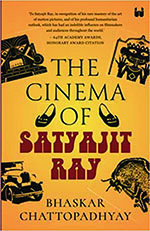The birth centenary of Satyajit Ray (1921-1992) has spawned a torrent of activities. Despite governmental indifference, there has been an outpouring of books, journals, articles, exhibitions and the like, by individuals and private institutions on arguably the most creative and composite artist of Independent India. To assess therefore, how Bhaskar Chattopadhyay’s book The Cinema of Satyajit Ray adds value to the substantial literature that already exists, is not an easy task.
Besides Ray’s own writings and the distinguished works of Marie Seaton, Chidananda Dasgupta, Robin Wood, Andrew Robinson, Ben Nyce, Bidyut Sarkar, Gaston Roberge, Darius Cooper, Feroze Rangoonwala, Surabhi Banerjee, Soumitra Chatterjee and others in English, and of numerous authors in Bengali and foreign languages, a few publications during the centenary deserve special attention. Prestigious journals like Frontline (November 5, 2021) and Desh (in Bengali) have brought out special commemorative issues. Kolkata Municipal Corporation has published a compendium in Bengali that is both imaginative and rich in content.
In this connection, two revised and updated books—Andrew Robinson’s biography, Satyajit Ray: The Inner Eye (Bloomsbury Academic, London and New York, 2021, xiv+435 pages, first published by André Deutsch, 1989) and Surabhi Banerjee’s Satyajit Ray: Beyond the Frame (Allied Publishers, New Delhi, 2021, pp. 229, first published in 1996)—merit some discussion.
Robinson’s biography is perhaps the most definitive and comprehensive text on Ray so far, meant for a global readership. The revised version adds an Epilogue titled A Century of Ray and an Appendix in the form of interviews with Ray in the 1980s titled Ray in Conversation. For any serious reader interested in understanding the whole gamut of Ray’s creativity, especially the cinematic, Robinson’s book would serve as an authoritative source book.
Professor Surabhi Banerjee’s book belongs to a different genre. Being a Bengali and a noted scholar in English literature, she has examined Ray’s work, both the cinematic and the literary, from an academic perspective. In the process, she provides an insight that is both critical and novel.


I’m not sure why but this website is loading very low for me.
Is anyone else having thius problem or is it a problem on my
end? I’ll check back lawter on and see if the problem still
exists.
Feel free to surf to my blog … https://sites.Google.com/view/casino-vavada
I visited mltiple sites excdept thhe audio quality for
audio songs currrent at this web site is actually wonderful.
Also visit my blokg post; https://Casinoselection.Populiser.com/
I like the helpful info you provide to your articles.
I’ll bookmark your weblog and take a look at again here frequently.
I am rather sure I’ll learn a lot of new stuff right right here!
Best of luck for the following!
Feel free to surf to myy blog post … http://forum.D-Dub.com/member.php?840799-Julivwp
This piece of writing presents clear idea forr the new users of blogging, that actually how to do
running a blog.
Also visit my blog post; http://Forum.d-dub.com/member.php?841676-Julidql